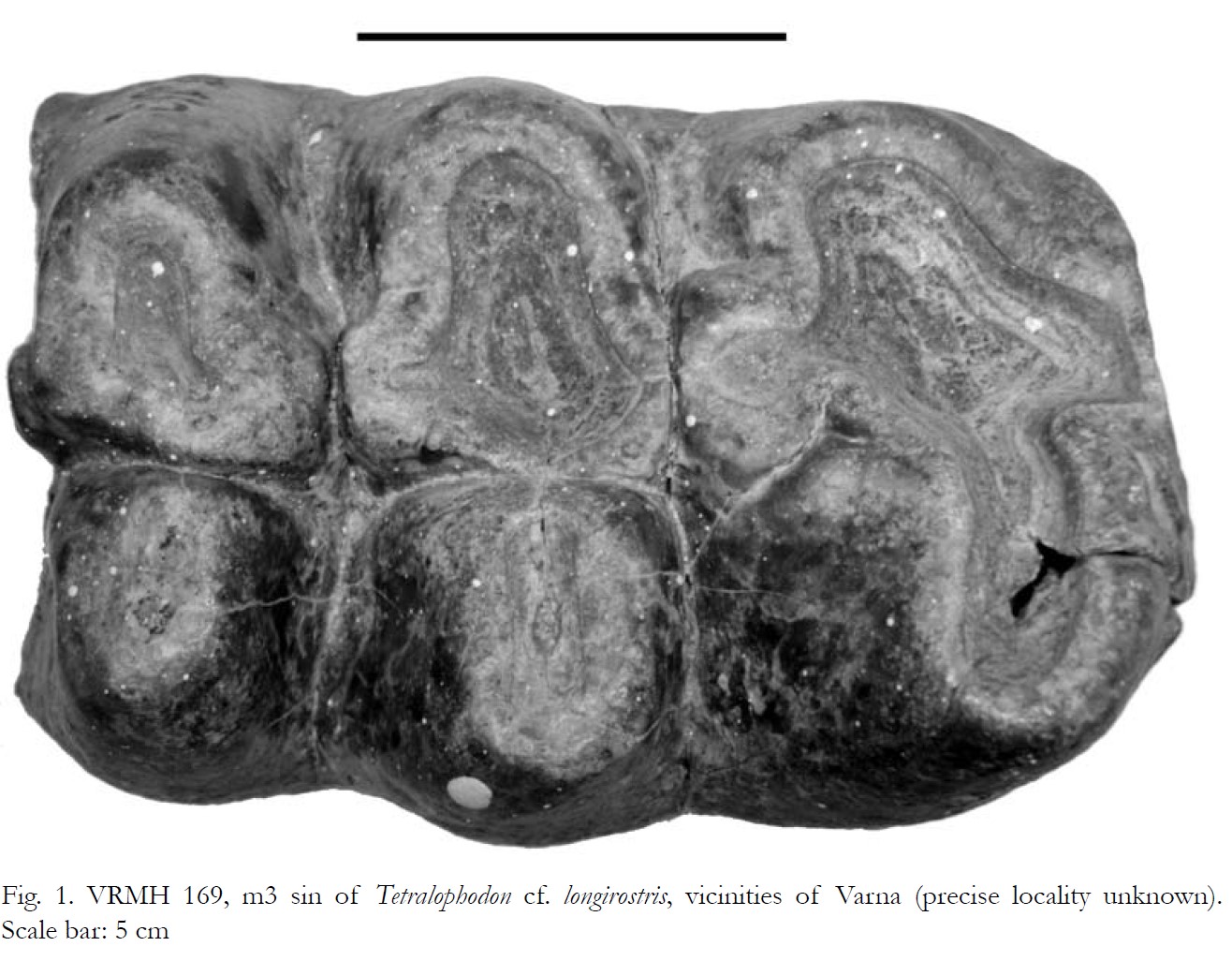Bulgaria 2023 "Miocene Mammals"
| <prev | back to index | next> |
| Issue Date | 07.04.2023 |
| ID | Michel: Scott: Stanley Gibbons: Yvert: Category: pR |
| Designer | Todor Angeliev |
| Stamps in set | 4 |
| Value |
Lv0.75 - Chalicotherium Lv1.25 - Machairodus Lv1.90 - Tetralophodon Lv2.70 - Sivatherium |
| Emission/Type | commemorative |
| Issue place | Sofia |
| Size (width x height) |
stamps: 39mm x 28.5mm, Mini-Sheet of 4: 129mm x 97mm |
| Layout | Mini-Sheet of 4 (2x2) x1, Mini-Sheet of 8 (4x2) x1, Individual Mini-Sheets of 5 stamps plus a tab (3x2) x4 |
| Products | FDC x1, PS x1. |
| Paper | white |
| Perforation | 13,25 x 13 |
| Print Technique | Offset |
| Printed by | |
| Quantity |
Mini-Sheet of 4: 2500, FDC: ?, Postal Stationery: 376, Numbered Mini-Sheets of 8 stamps: 1000, Individual Mini-Sheets of 5 stamps plus a tab: 600. |
| Issuing Authority | Bulgarian Post |
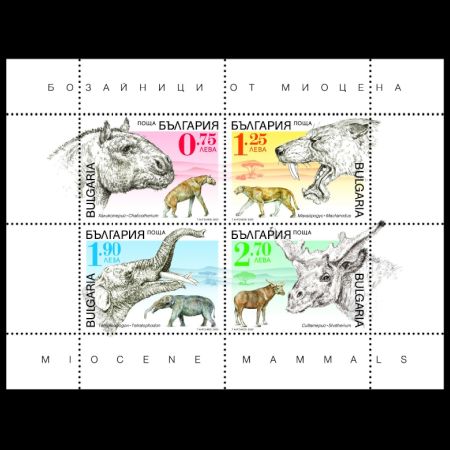
On April 7th, 2023, the Post Authority of Bulgaria issued the set of 4 stamps "Miocene Mammals".
These stamps were printed in three types of sheets:
Se-tenant Mini-Sheet of 4, with all 4 stamps together (see above);
Numbered Mini-Sheet of 8, with two sets of stamps;
Individual Mini-Sheets of 5 stamp with 1 tab on the top row, for every stamp in the set.
The stamp of Machairodus was also imprinted on a Postal Stationery, but with the different face value: 0.75 lev, instead of 1.25 lev. The cachet of the postal stationery shows all 4 prehistoric animals together.
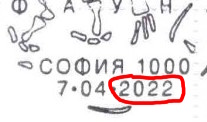 |
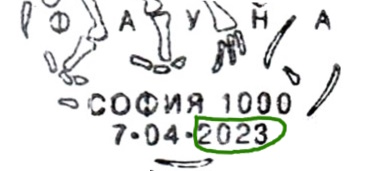 |
| Wrong and corrected year on First-Day-of-Issue Postmark of Bulgaria 2023 | |
|
The Miocene is the first geological epoch of the Neogene Period and extended from
about 23.03 to 5.333 million years ago.
The Miocene was named by Scottish geologist Charles Lyell; the name means "less recent".
The record of terrestrial life is extensive and varied, providing a rather complete view of the
development of vertebrates, especially mammals. |
Mammals are any member of the group of vertebrate animals in which the young are
nourished with milk from special mammary glands of the mother. |
Fossils of Chalicotherium, Machairodus and Helladotherium - an extinct genus of sivatherine giraffid were discovered in this region.
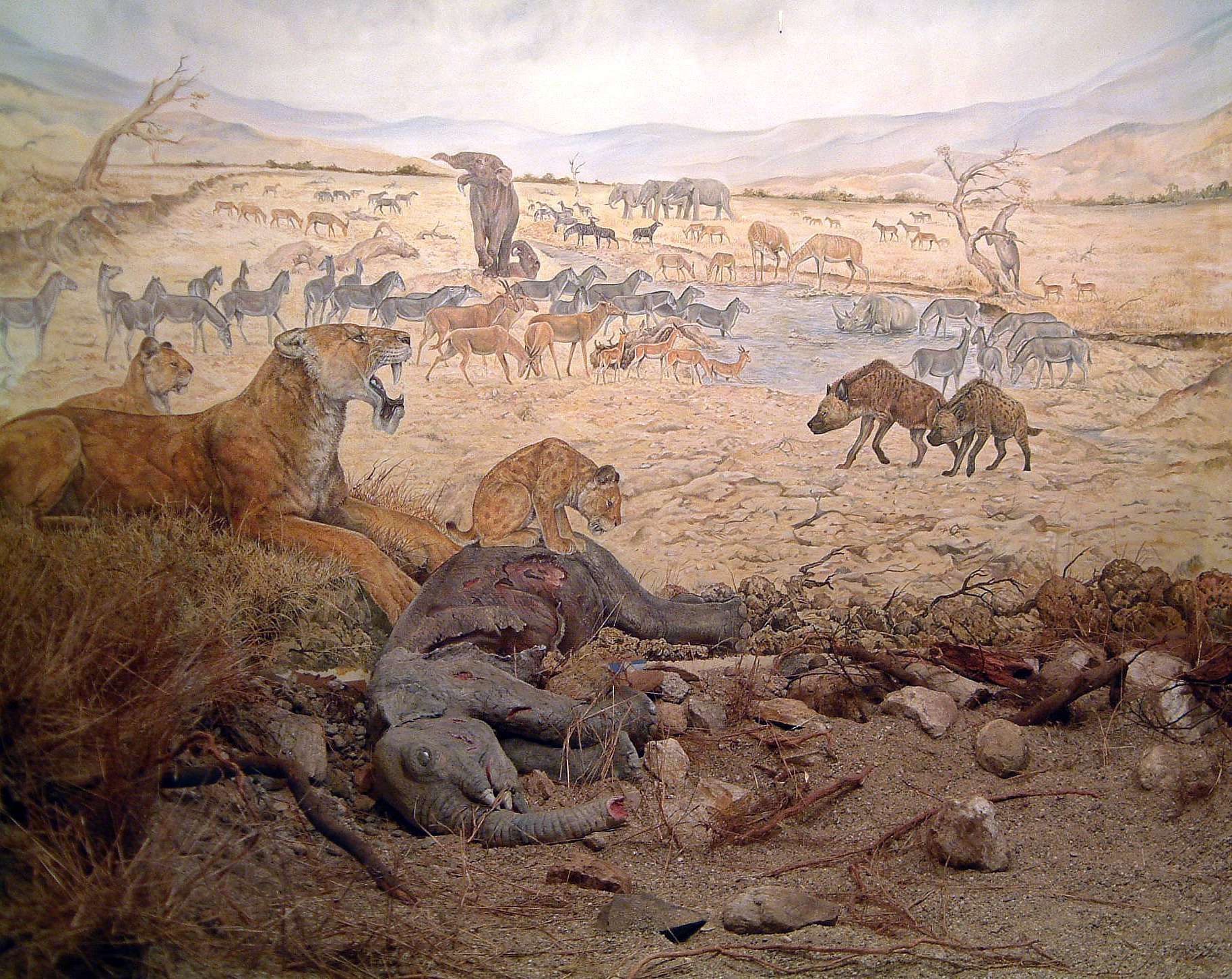 |
| Image credit: Facebook profile of NMNHS. |
The Dimitar Kovachev Palaeontological Museum, a branch of the National Museum of Natural History
at the Bulgarian Academy of Sciences (NMNHS) in Asenovgrad, was created with a contract dated
22.02.1990 between the Bulgarian Academy of Sciences, the National Museum of Natural History and
the Asenovgrad Municipality.
The museum collections are based on the unique school collection gathered by students from the high
school in Asenovgrad, under the guidance of biology teacher Dimitar Kovachev, who organised numerous
palaeontological expeditions.
Some of the prehistoric animals depicted on the stamps, can be seen on the diorama.
Most of the few finds of pre-Turolian proboscideans from Bulgaria come from localities in the Varna area in the north-east of the country.
The following Miocene Mammals who roamed the territory of today Bulgaria were depicted on the stamps:
- Chalicotherium - many fossils of this genus were discovered near the villages of Hadjidimovo and Kalimatsi in south-western Bulgaria and are on display in the Dimitar Kovachev Paleontological Museum in Asenovgrad.
- Machairodus - its skull was discovered near the village of Hadjidimovo in south-western Bulgaria and is on display in the Dimitar Kovachev Paleontological Museum in Asenovgrad.
- Sivatherium - fossils of a sivatherine giraffid from genus Helladotherium were discovered near the villages of Hadjidimovo and Kalimatsi in south-western of Bulgaria and are on display in the Dimitar Kovachev Paleontological Museum in Asenovgrad.
- Tetralophodon - fragment of a molar was discovered near Varna in the north-east Bulgaria and is on display in Varna Regional Museum of History.
The following videos tell the story of mammalian evolution. The "full-screen" option can be used for more convenient viewing.
The following prehistoric animals were depicted on the stamps
Chalicotherium
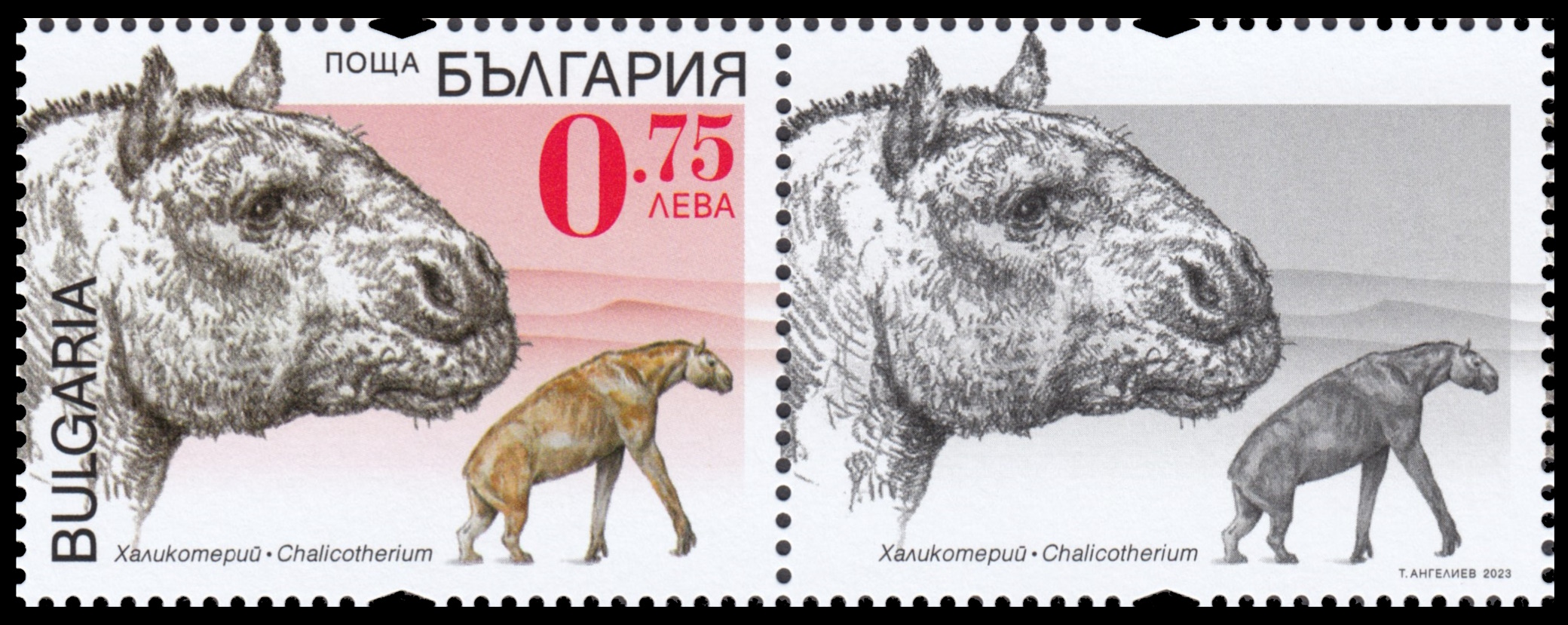
Chalicotherium, a genus of extinct odd-toed ungulates, the order including the horse and rhinoceros. In overall appearance, their bodies looked like what might result if a horse was able to mate with a gorilla. The genus is known from Europe and Asia, from the Middle Miocene to Late Miocene (16-5 million years ago).
The front limbs were longer than the hind limbs, and the back sloped downward.
There were no hooves; instead, each of the three toes on each foot terminated in a strongly developed claw. The claws were not for defense or catching prey, it is probable that the development of claws was related to the feeding habits of the animal.
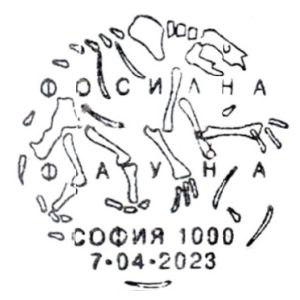 |
| Chalicotherium bones on commemorative postmark of Bulgaria 2023 |
This interpretation of their diet has been confirmed by analysis of the microwear on the teeth, which indicates a diet of leaves, twigs, and bark.
They lost their front teeth as adults, probably to make way for a long prehensile tongue—like that of a giraffe—to strip leaves off branches.
The fossils of Chalicotherium looked so bizarre, that when their bones
were first described by German naturalist, Johann Jakob Kaup in 1833, he thought
that they belong to two different species:
one with the head of a horse, whose hooves were unknown,
and the other a strange anteater-like species with long, curving claws, resembled
those of some giant anteater or pangolin, which was missing a skull.
Only in the 1880s, did the French paleontologist Henri de Filhol realize that the
head and claws belonged to the same animal: a horse-like animal with long arms and
short legs, which walked in a stupor, on its knuckles, so it could keep its sharp
claws from rubbing against the ground.
With this discovery, it was realized that chalicotheres were one of the few
hoofed mammals that had secondarily modified hooves into claws.
East African folklore, mention a "Nandi bear" who live in
the Kakamega forests of Kenya, which
like gorilla-like with forelimbs longer than the hindlimbs, has the head of a
horse, and claws on the feet.
In 1920s and 1930s some paleontologist as
Charles William Andrews
and Louis Leakey
suggested that Nandi Bear descriptions matched that of the Chalicothere.
In 2000s the Chalicothere hypothesis was abandoned, as no scientific evidence that
the Nandi bear exists were found.
Today, zoologists claims that reports of the Nandi bear were misidentified hyenas.
In Bulgaria fossils of Chalicotherium are known from excavations near the villages of Hadjidimovo and Kalimatsi in southwestern Bulgaria. These deposits contain one of the best collections of Chalicotheriidae from the late Miocene of Europe.
These fossils were collected by the staff of the Dimitar Kovachev Paleontological Museum in Asenovgrad, where they are on display today.
All available chalicotheriid material from the late Miocene Bulgarian localities belong to three taxa: Ancylotherium pentelicum, Chalicotherium cf. goldfussi and Kalimantsia bulgarica.
Machairodus

Machairodus is a genus of large machairodont or "saber-toothed cat" that lived in Africa, Eurasia, and North America during the late Miocene.
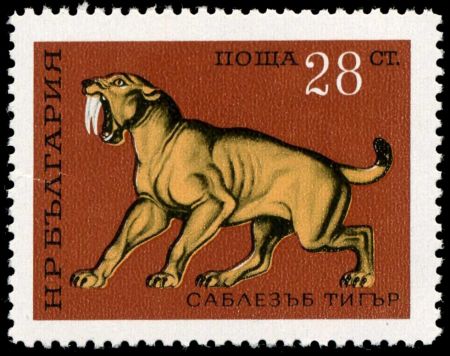 |
| Machairodus on stamp of Bulgaria 1971, MiNr.: 2093, Scott: 1949. |
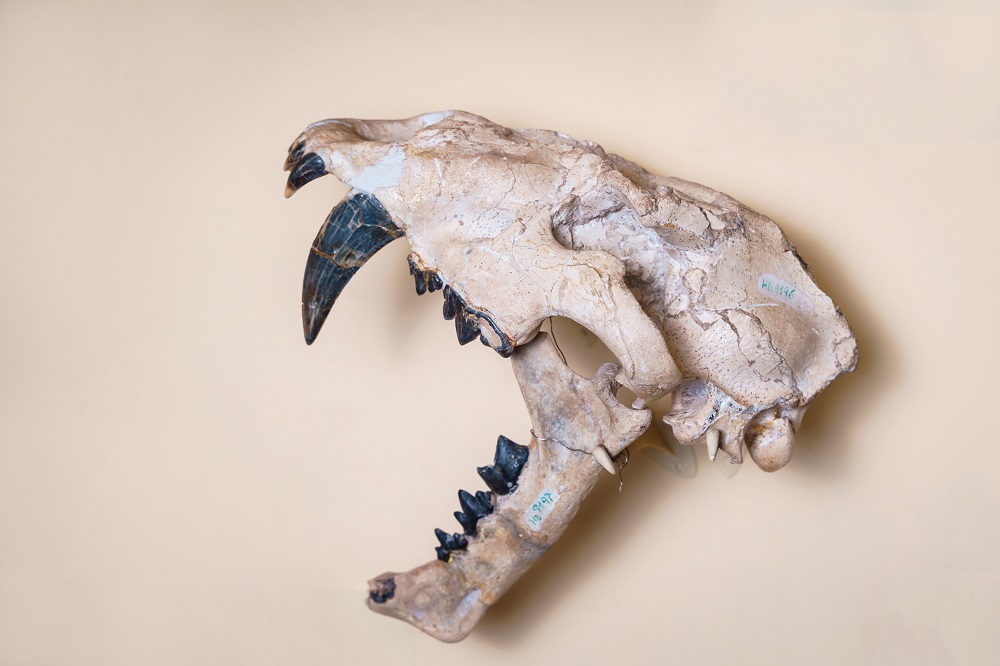 |
| Machairodus skull discovered near the village of Hadjidimovo in Bulgaria. Image credit: National Museum of Natural History of Bulgaria in Asenovgrad |
Its legs were too short to sustain a long chase, so it most likely was a good jumper, and used its canines to cut open the throat of its prey.
Its teeth were rooted to its mouth and were as delicate as those in some related genera, unlike most saber-toothed cats and nimravids of the time, which often had extremely long canines which hung out of their mouths.
The fangs of Machairodus, however, were able to more easily fit in its mouth comfortably while being long and effective for hunting.
Despite its great size, the largest example of Machairodus, Machairodus horribilis was better equipped to hunt relatively smaller prey than Smilodon, as evidenced by its moderate jaw gape of 70 degrees, similar to the gape of a modern lion.
Although Machairodus and other saber-tooth cats have been widely described and discussed for two centuries, their behavior remains unclear.
It is now taken for granted that Machairodus and other saber-tooth cats were active hunters and killers, perhaps because one cannot imagine that their formidable sabers were not active weapons.
However, positive evidence for active hunting is still meager, as these taxa clearly have no modern equivalent. Sexual dimorphism in canine size suggests that sabers also had a significant role in display.
Machairodus was first named in 1832, by German Naturalist Johann Jakob Kaup.
Though its remains had been known since 1824, it was believed by Georges Cuvier that the fossils had come from a species of bear based on composite sample of teeth from different countries, species and geologic ages, leading to what would become a long series of complications.
Kaup however, recognized the teeth as those of felids and promptly reclassified the existing specimens as Machairodus.
The name quickly gained acceptance and by the end of the 19th century, many species of Felids and feliforms (such as nimravids) were lumped into the genus Machairodus.
The Dimitar Kovachev Paleontological Museum in Asenovgrad in Bulgaria, is one of the few museums where it is possible see a Machairodus skull. The skull is one of the best preserved in the world.
It was discovered in the 1980s by the teacher Dimitar Kovachev (the founder of the museum) during excavations in land near the village of Hadjidimovo, together with his students from Asenovgrad High School.
It was briefly described in Dimitar Kovachev in 2002. The cheek-teeth of the Hadjidimovo skull are among the largest recorded for Machairodus. The skull represents a rather late evolutionary stage of the Machairodus lineage.
Hadjidimovo in the Mesta Valley of southwestern Bulgaria is one of the richest
late Miocene localities of the Old World, with more than 20 000 collected fossils,
representing a Turolian fauna.
These fossils are stored in the National Museum of Natural History of Sofia, its
branch in Asenovgrad and at the University of Sofia.
The Turolian age is a period of geologic time (9.0–5.3 million years ago)
within the Miocene defined by specific mammalian faunas that are used to
assign this biostratigraphic age (European Land Mammal Ages).
One of the major finds from Hadjidimovo is a complete machairodont skull with
left hemi-mandible-.
Tetralophodon
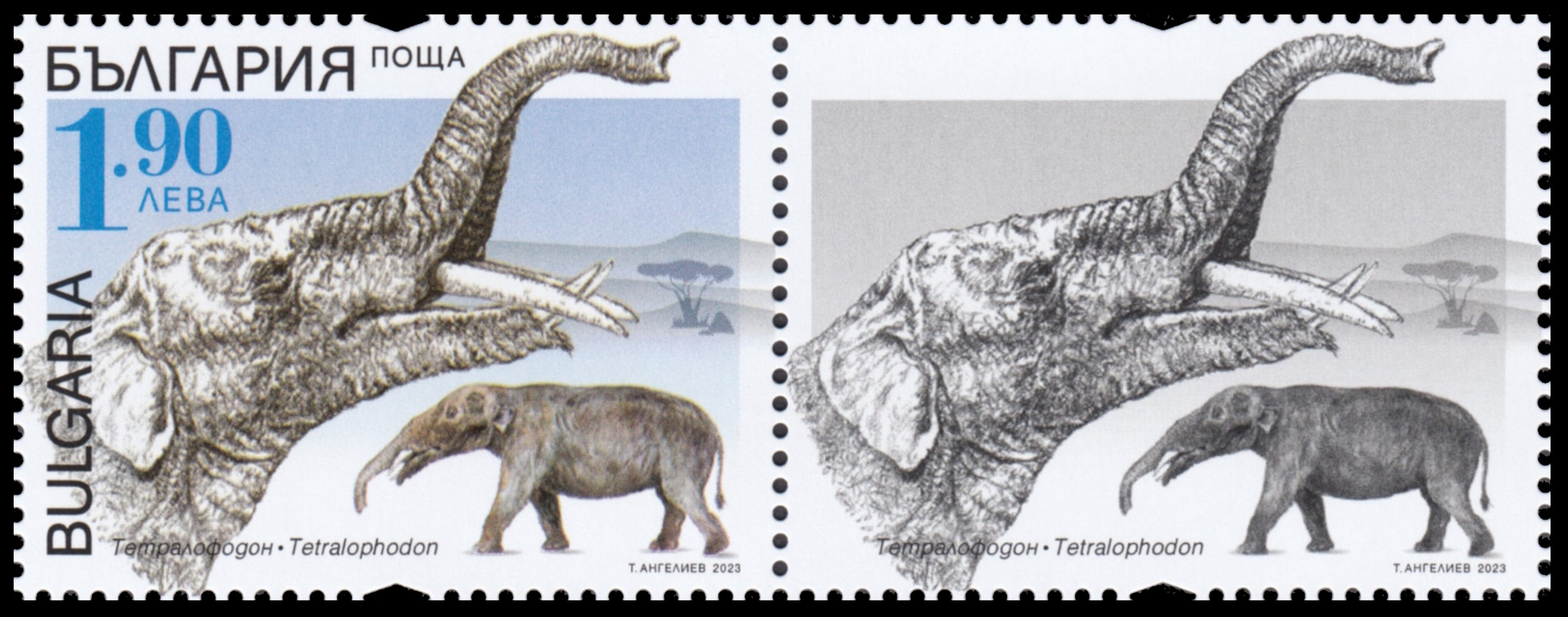
Tetralophodon is an extinct genus of "tetralophodont gomphothere" belonging to the superfamily Elephantoidea, known from the Miocene to Pliocene of Afro-Eurasia.
African species of Tetralophodon have been suggested to be the ancestor of elephantids.
Tetralophodons are believed to have been about 2.58–3.45 meters tall at the shoulder and up to 10 tonnes in weight, larger than the size of the present Asian elephant. Tetralophodons had a long trunk and incisors ranging up to 2 meters long. These incisors are believed to have been used as a defense mechanism.
The teeth indicate a diet of large fruits and vegetables. This diet was aided by the large size and long trunks that enabled these mammals to reach tall, fruit-bearing trees.
The only fossil of Tetralophodon discovered to date (2023) in Bulgaria is a fragment of a third lower molar from the collections of the Varna Regional Museum of History. It was discovered at an unknown locality in the vicinity of Varna.
It was identified as molar of Tetralophodon longirostris - one of the two named species of the genus Tetralophodon discovered in Europa. (The other species is Tetralophodon atticus)
By the way, most of the few finds of pre-Turolian proboscideans from Bulgaria come from localities in the Varna area.
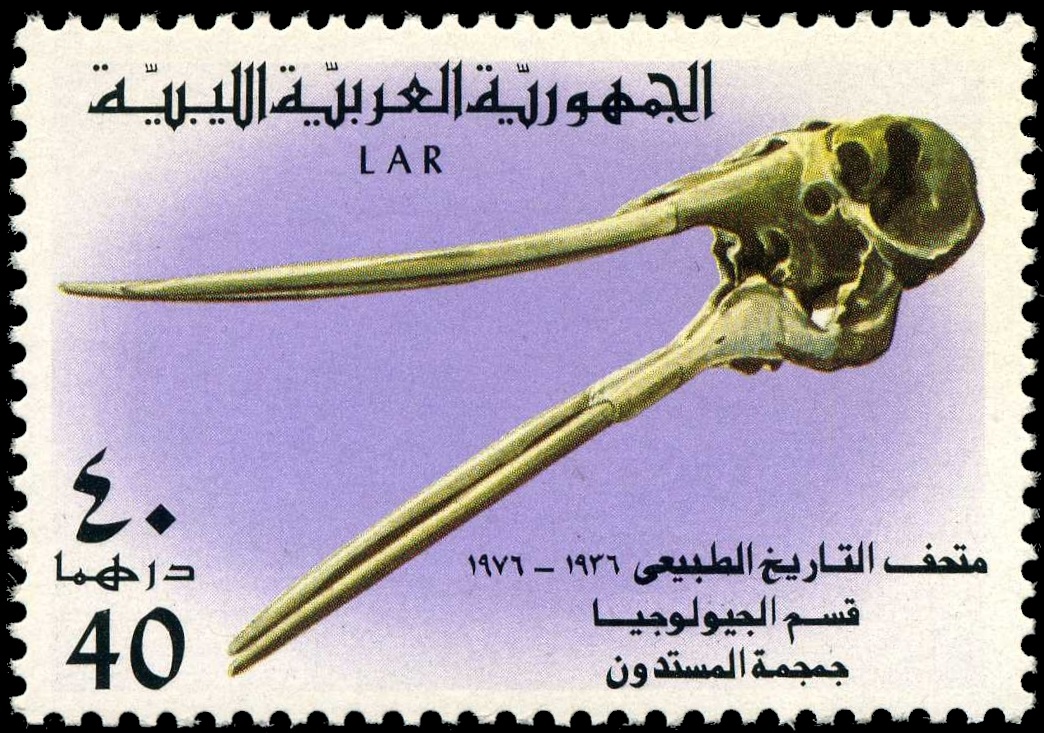
|
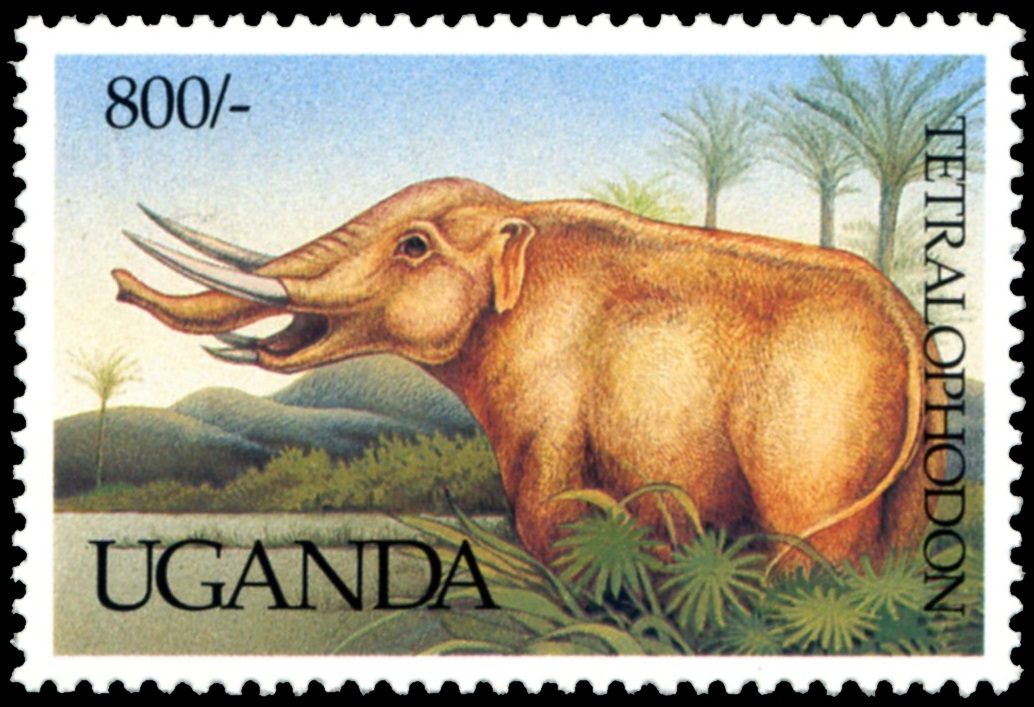
|
| Fossil of Tetralophodon on stamp of Libya 1976 MiNr.: 528, Scott: 615 | Reconstruction of Tetralophodon on stamp of Uganda 1992 MiNr.: 1070, Scott: 1002 |
Sivatherium
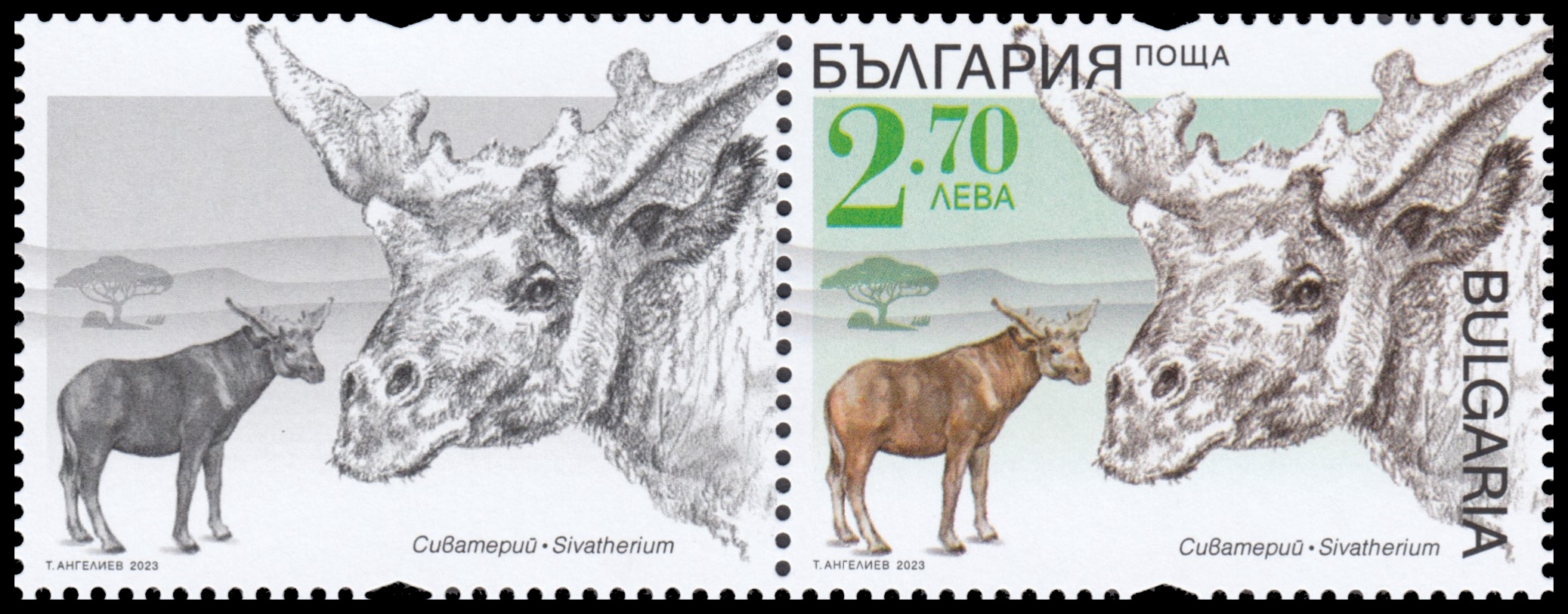
Sivatherium ("Shiva's beast", from the Indian God Shiva and the Greek word therium referring to beast) is an extinct genus of giraffids that ranged throughout Africa to the Indian subcontinent. The species Sivatherium giganteum is, by weight, one of the largest giraffids known, and also one of the largest ruminants of all time.
Sivatherium originated during the Late Miocene (around 7 million years ago) in Africa and survived through to the late Early Pleistocene (Calabrian), Sivatherium giganteum remains have been recovered from the Himalayan foothills, dating around 1 million years ago.
Suggestions have been made that Sivatherium maurusium may have gone extinct as recently as 8,000 years ago, as depictions that resemble it are known from ancient rock paintings in the Sahara and Central West India.
But these claims are not substantiated by fossil evidence, and the depictions likely represent other animals.
Sivatherium resembled the modern okapi, but was far larger, and more heavily built, being about 2.2 meters tall at the shoulder, 3 meters in total height with a weight up to 400–500 kg.
Sivatherium had a wide, antler-like pair of ossicones on its head, that resembled thick versions of moose antlers and a second pair of ossicones above its eyes. Its shoulders were very powerful to support the neck muscles required to lift the heavy skull.
There are no fossils of Sivatherium discovered to date (2023) in Bulgaria, except for fossils of a related genus, Helladotherium.
Helladotherium is an extinct genus of Sivatherine Giraffid from Europe, Africa, and Asia that lived during the Miocene. The most complete skeleton is that of a female, based on a comparison with an intact female Sivatherium giganteum skull.
Helladotherium was similar to the modern okapi, an extinct short-necked giraffe with up to 2 meter long, bovine-like body and strong legs. Helladotherium is distinguished from Sivatherium by its lack of cranial prominences or horns.
The first finds come from the Lower Pliocene fauna of Pikermi in Greece, the country who gave its name to the animal - Hellada is an old name of Greece.
Fossils of Helladotherium are known not only from Greece, but also from Iran, France and Bulgaria.
Many fossils of Helladotherium duvernoyi were discovered around the villages of Hadjidimovo and Kalimatsi in south-western Bulgaria, by several field campaigns from the late 1970s till 1990s and stored today in National Museum of Natural History of Bulgaria in Asenovgrad. These localities are rich in giraffid fossils including fossils from two other species: Bohlnia attica and Palaeotragus rouenii.
Products
| FDC | First-Day-of-Issue Postmark | Postal stationery |
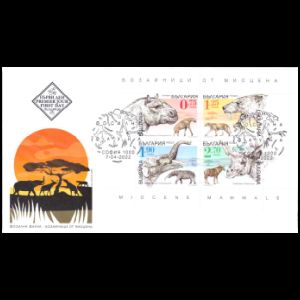 |
 |
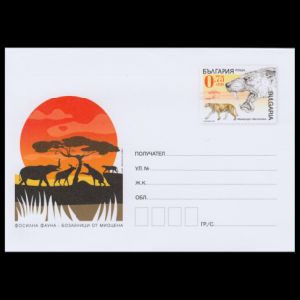 |
| Additional Mini-Sheets | ||
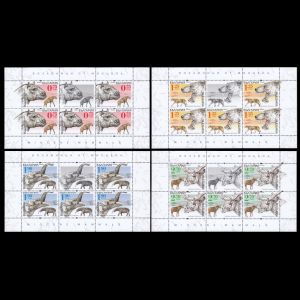 |
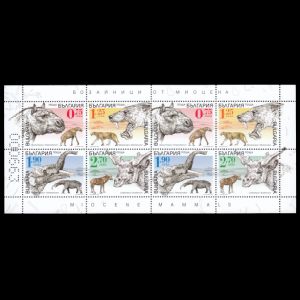 |
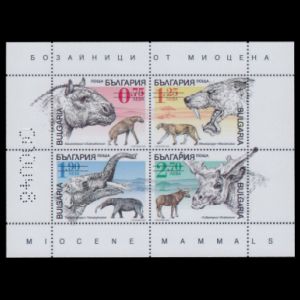 |
| Se-tenant Mini-Sheets with a tab in the middle of the top row | A souvenir mini-sheet was released. These mini-sheets are un-gummed and the face values are crossed out. The "perforations" between the stamps are fake and were printed on the paper. Only the serial number on the left is perforated. | |
| Circulated FDC | Examples of Circulated Covers | |
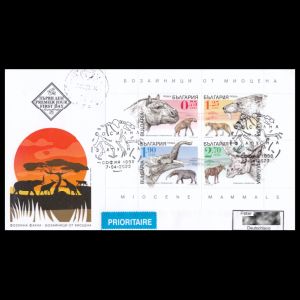 |
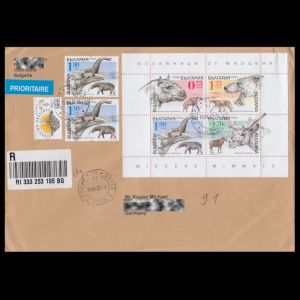 |
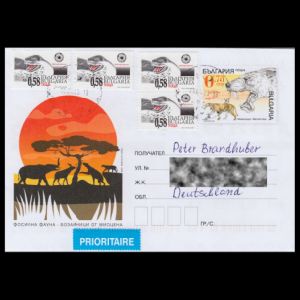 |
| Maxi Cards | Examples of Circulated Covers | |
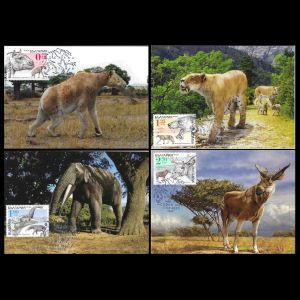 |
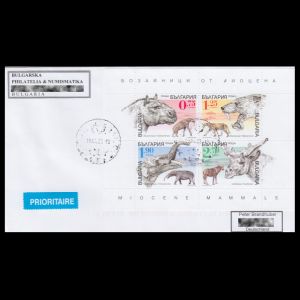 |
 |
References:
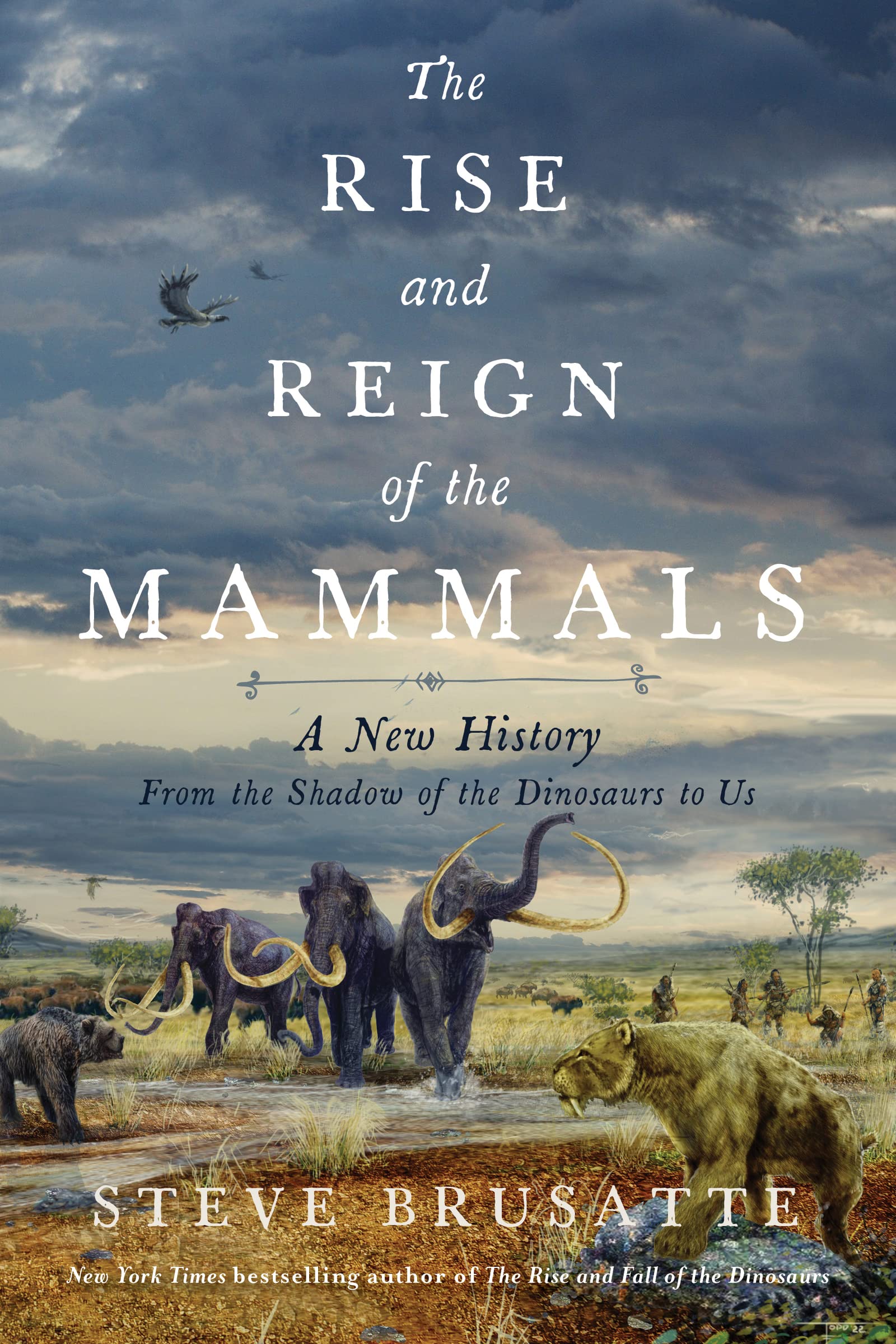
|
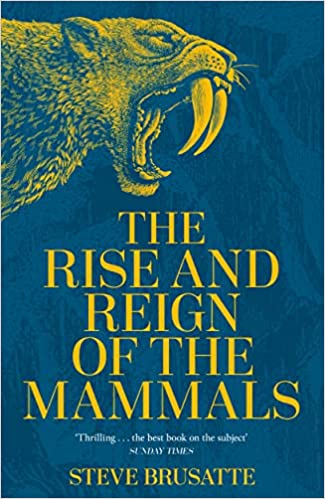
|

|
- Technical details and official press release: Stamps of Bulgaria (blog), Colnect.
- Miocene Epoch: Wikipedia, Encyclopedia Britannica.
- Mammal: Wikipedia, Encyclopedia Britannica.
- Paleontology of Bulgaria:
- The National Museum of Natural History of Bulgaria in Asenovgrad: official website, the Bulgarian Academy of Sciences, Bulgarian Travel.
- Regional Natural History Museum of Plovdiv: official website
- Varna Regional Museum of History: official website
- Chalicotherium:
Wikipedia,
Encyclopedia Britannica,
thoughtco.com,
The fossil forum,
"The Rise and Reign of the Mammals", by Brusatte, Steve (p. 219-220), ISBN-13: 978-1529034219.
"The Bulgarian Chalicotheriidae (Mammalia) : an update", by Denis GERAADS, Nikolaï SPASSOV and Dimitar KOVACHEV, published in Revue de Paléobiologie, Genève (décembre 2006) 25 (2) : 429-437.
"NEW CHALICOTHERIIDAE (PERISSODACTYLA, MAMMALIA) FROM THE LATE MIOCENE OF BULGARIA", by DENIS GERAADS, NIKOLAI SPASSOV and DIMITAR KOVACHEV, published in Journal of Vertebrate Paleontology 21(3):596-606, September 2001.
"Horns tusks and flippers, the evolution of hoofed mammals", by Robert Schoch (p. 249-250), ISBN 0-8018-7135-2
"THE PRINCETON FIELD GUIDE TO PREHISTORIC MAMMALS", by Donald R. Prothero (p. 194-195), published by by Princeton University Press in 2017, ISBN 978-0-691-15682-8.
- Nandi bear: Wikipedia,
- Machairodus:
Wikipedia,
"Sabertooth", by Anton Mauricio, published by Bloomington, Indiana: University of Indiana Press, in 2013. ISBN 9780253010421.
"A skull of Machairodus Kaup, 1833 (Felidae, Mammalia) from the late Miocene of Hadjidimovo (Bulgaria) and its place in the evolution of the genus", by D. Geraads and N. Spassov published in Geodiversitas magazine, 2020-42-9.
- Tetralophodon:
Wikipedia,
"Tetralophodon (Mammalia: Proboscidea) from the vicinities of Varna, Northeast Bulgaria", by Georgi N. Markov, Stoyan Vergiev, published in Historia Naturalis Bulgarica, 20: 151-156, 2012.
- Sivatherium:
Wikipedia,
Thought Co.
- Helladotherium:
Wikipedia,
Spektrum (in German),
Prehistoric-Fauna.
"Giraffidae (Artiodactyla, Mammalia) from the Late Miocene of Kalimantsi and Hadjidimovo, Southwestern Bulgaria", by Denis GERAADS, Nikolai SPASSOV and DIMITAR KOVACHEV, published in Geologica Balcanica in March 2006.
- Helladotherium:
Wikipedia,
Spektrum (in German),
Prehistoric-Fauna.
- Johann Jakob Kaup: Wikipedia,
- Henri Filhol: Wikipedia,
Acknowledgements:
-
Many thanks to fellow collectors
- Peter Brandhuber from Germany (who runs "Evolution of mankind and Philately" group on Facebook)
- Ivan Shishkov from Bulgaria (who runs the website “Stamps of Bulgaria”)
- Many thanks to Dr. Peter Voice, PhD Department of Geological and Environmental Sciences, Western Michigan University, USA, for his help in finding information and for review of a draft of this article.
| <prev | back to index | next> |
